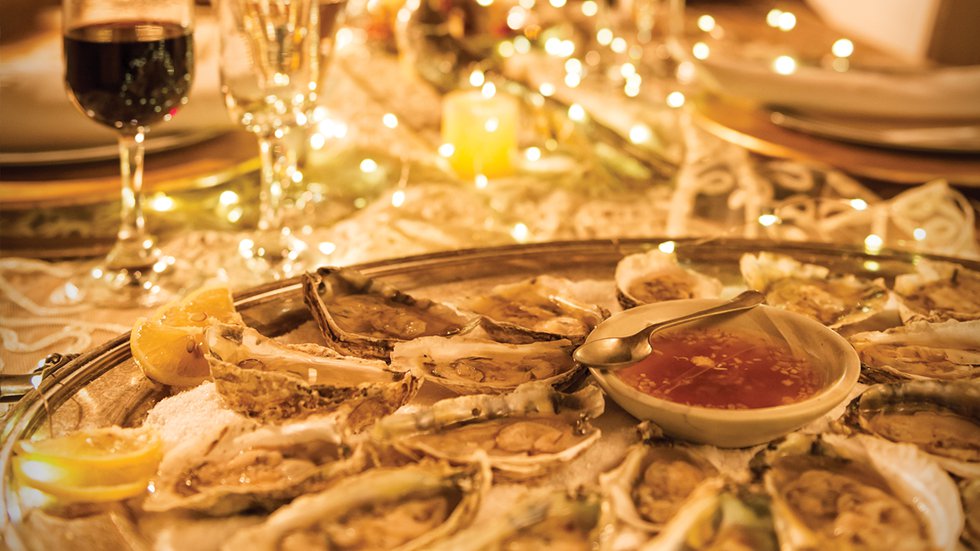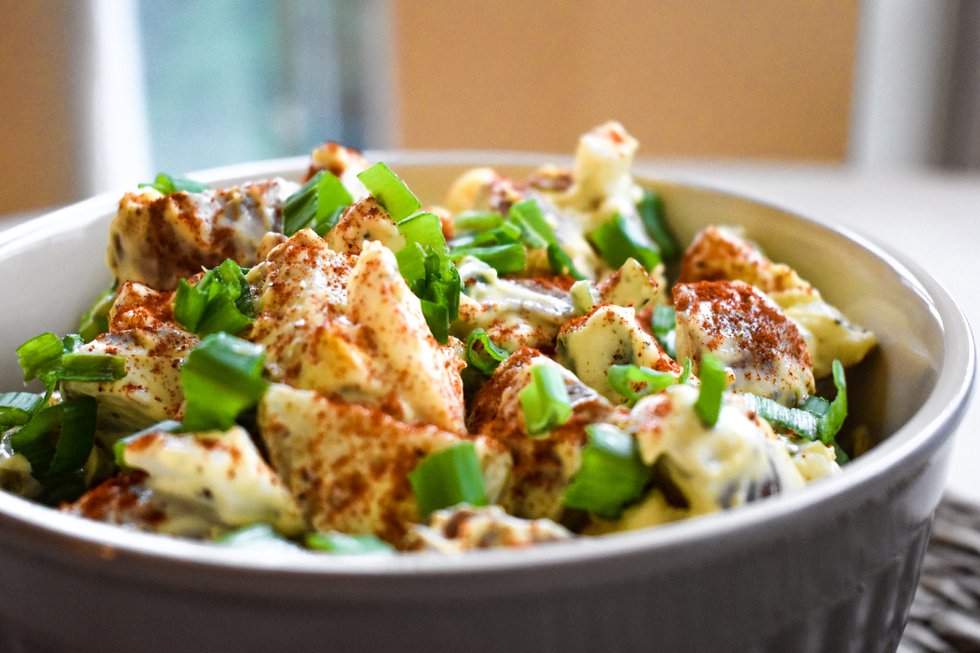The pleasures of the cup shouldn’t be limited to cocktail hour. Punctuating your recipes with smoky whisky, flavorful bourbon or citrusy gin will add a depth of flavor to your cooking that is anything but boozy.

Rappahannock oysters with “Fizz” mignonette.
Photos by Mark Edward Atkinson

Rappahannock oysters with “Fizz” mignonette.

Potter’s Craft cider brined and glazed pork shoulder roast with Champion Killer Kolsch onion rings.

Laird’s apple brandied carrots and cauliflower with citrus.

Virginia Distillery Highland Malt Whisky roasted mushroom, farro and greens salad.

Rosemary beet chips with Silverback vodka crème fraîche and trout roe.

Pear Galette.
The pleasures of the cup shouldn’t be limited to cocktail hour. Why not extend the good cheer of your favorite libation to the holiday table? Punctuating your recipes with smoky whisky, flavorful bourbon or citrusy gin will add a depth of flavor to your cooking that is anything but boozy.
“I love cooking with cider,” says Daniel Potter of Potter’s Craft Cider in Free Union, whose product is a natural complement to pork or duck. “Our Farmhouse Dry has bright fruit flavors and lively acidity that are intensified in reductions and glazes.”
“We use Virginia cider in shellfish dishes during the fall, usually something on draft,” says Chef Lee Gregory of The Roosevelt and Southbound, a pair of Richmond restaurants. “We steam mussels or clams with cider, chorizo and fennel. It’s a great way to add flavor, and to use a local product.”
The alcohol’s harsher notes evaporate in the cooking process, amplifying and uniting the flavors around it. Natural meat tenderizers, liquor, wine and beer break down meat protein (though they can make meat mushy if left too long) and infuse it with the maltiness of a stout or the decadence of a rich, bold red wine.
Says Dan Fitzhenry, of Virginia Distillery Company in Lovingston, “One of my favorite things in the world is cooking with whisky, both in the recipe, and also with a glass full—those notes of dried fig, subtle toffee, and dark cocoa couldn’t be more perfect in a warm kitchen on a cold day.”
We heartily agree. Here, we offer a menu for your holiday table that is sure to create a spirited celebration.
To see a new, web-exclusive recipe for Pear Galette, scroll to the bottom of this page.
Rappahannock Oysters with “Fizz” Mignonette
1 cup Thibaut-Janisson “Fizz” or sparkling white wine 2 shallots, minced zest of ½ lemon peel 1 tablespoon white wine or rosé vinegar ½ teaspoon coarsely ground pepper ½ teaspoon sugar 2 dozen Rappahannock or Virginiaoysters, shucked shaved ice, for serving For the mignonette: In a bowl, combine the sparkling white wine, shallots, vinegar, lemon peel zest, sugar and pepper. Make at least 12 hours in advance and chill. Arrange the oysters on a bed of ice and serve with the chilled mignonette. Serves 8
Virginia Distillery Highland Malt Whisky Roasted Mushroom, Farro and Greens Salad
1 ½ cup uncooked farro kosher salt 6 tablespoons olive oil 1 pound oyster mushrooms 2 sprigs fresh thyme 1 ounce Virginia Distillery Highland Malt Whisky 1 teaspoon sherry vinegar 2 bunches curly kale, coarsely torn ¼ cup roughly chopped parsley fresh ground black pepper
Heat the oven to 350 degrees. In a medium saucepan, combine the farro and enough cold water to cover it by about an inch. Soak for 20 minutes. Drain well and return the farro to the pan, again covering it with cold water. Add a few generous pinches of salt and bring to a boil over high heat. Lower the heat, cover and simmer for 20 minutes, until the farro is tender but still has some bite.
While farro is cooking, clean mushrooms and tear into ½-inch wide strips. Heat large sauté pan to high heat. Add 2 tablespoons olive oil to pan along with generous pinch of kosher salt. Once oil is hot (15 seconds or until slightly smoky) add mushrooms and thyme. Sauté mushroom strips on high heat until edges become crispy and golden brown. Remove pan from heat and turn off gas burner (if applicable) before adding whisky to mushrooms. Carefully place pan back on burner and cook on high heat until whisky is completely reduced, at which point spoon mushrooms onto a plate and let cool. Discard thyme.
When the farro is cooked, drain it well and spread it on a clean baking sheet to cool. When the farro and mushrooms are close to room temperature, or just barely warm, combine them in a serving bowl with kale. Add sherry vinegar and 4 tablespoons of olive oil, tossing gently to combine. Finally, add parsley and a generous grinding of pepper and fold gently. Taste and add more salt and pepper if necessary. Serve at room temperature.
Serves 8
Rosemary Beet Chips with Silverback Vodka Crème Fraîche and Trout Roe
For vodka crème fraîche:
1 cup whipping cream 2 tablespoons buttermilk 2 tablespoons Silverback vodka
Combine 1 cup whipping cream and 2 tablespoons buttermilk in a glass container. Cover tightly with plastic wrap and let stand at room temperature (about 70 degrees) for 24 hours, or until very thick. Stir well before covering. Fold in vodka when thickened and refrigerate up to 10 days.
For the rosemary beet chips:
2 large beets, thinly sliced with a mandoline or the slicing mechanism in a food processor 2 sprigs of rosemary 2 cups extra virgin olive oil for pan-frying sea salt 2 ounces Virginia trout roe
Warm olive oil in a large pot over high heat to 350 degrees with rosemary. Meanwhile, trim 1 inch off the root end of the beets. Using a mandoline, slice the beets into very thin slices, about 8-inch thick.
When the oil reaches 350 degrees, remove rosemary and fry beets a single layer at a time. Fry until curled at the edges and most of the bubbling has subsided, about 3 to 4 minutes. Transfer the beets to a paper towel-lined baking sheet and sprinkle with sea salt. Continue with the remaining beets. Let cool and transfer to a serving plate. Top with a teaspoon of chilled crème fraîche and ¼ teaspoon Virginia trout roe. Serve at room temperature.
Serves 8
Potter’s Craft Cider Brined & Glazed Pork Shoulder Roast with Champion Killer Kolsch Onion Rings
5-pound boneless pork shoulder tied, with fat cap trimmed to ½ inch* 1 cup (packed) light brown sugar 1 cup kosher salt, plus more as necessary to taste 5 sprigs fresh thyme 1 clove 2 allspice berries 2 bay leaves 1 tablespoon coriander seeds 2 Chile de Arbol peppers, whole (½ teaspoon chili flake can substitute; chilis can be deseeded to reduce spice)1 teaspoon black peppercorns, plus more freshly ground to taste2 cups water 1 quart Potter’s Craft Farmhouse Dry cider, chilled 2 cups ice 1 tablespoon extra virgin olive oil 2 cups pork stock
*When buying pork shoulder, ask your butcher to trim and tie.
Combine brown sugar, 1 cup salt, thyme, clove, allspice berries, 2 bay leaves, 1 tablespoon coriander seeds, Chiles de Arbol, 1 teaspoon peppercorns and 2 cups water in a medium saucepan and bring to a boil. Reduce heat and simmer, stirring occasionally, until sugar and salt dissolve, about 4 minutes. Transfer brine to a large bowl and add cider and 2 cups ice. Let cool.
Place pork and brine in a large (2-gallon) resealable plastic bag, making sure the brine covers the meat. Seal bag and refrigerate 24-48 hours.
Remove pork from brine and pat dry with paper towels. Set brine aside and save. Let pork sit at room temperature for 1 hour. Pre-heat oven to 375 degrees.
Heat large oven-ready skillet with olive oil to medium-high heat; must be large enough to fit shoulder roast. Season roast with about 2 tablespoons of salt and enough pepper for a good dusting. Sear on all sides to a dark golden brown, beginning with the fat side down. In skillet, transfer from stove top to oven. Roast shoulder for 3 hours at 350 degrees, basting with rendered fat from pan every 30 minutes. Remove when internal temperature reaches 135 degrees and let rest, allowing internal temperature to rise to approximately 140 degrees. This will render the roast medium and a beautiful pink inside.
While pork is resting, drain fat from pan, deglaze pan with ½ cup brine and 2 cups pork stock. Reduce until slightly thickened. Slice roast and pour pan glaze over top of roast. Serve warm with onion rings on top.
For Champion Killer Kolsch onion rings:
4 sweet onions, such as Vidalia or Walla Walla 1 cup all-purpose flour 2 tablespoons cornstarch 1 teaspoon kosher salt ½ teaspoon fresh ground black pepper 1 teaspoon cayenne pepper 1 12-ounce can Champion Killer Kolsch beer 1 cup sparkling mineral water 2 tablespoons extra virgin olive oil 4 cups vegetable oil
Pre-heat oven to 425 degrees. While oven heats, slice off the root and tip ends of the onions. Peel the onions and cut them crosswise into ¼-inch to ½-inch thick slices. Separate slices into individual rings, discarding the centers. Toss onions lightly in salt, pepper and 2 tablespoons extra virgin olive oil to taste. Roast onions on baking sheet until they begin to soften.
While onions are roasting, fill a heavy Dutch oven or cast iron pot with a few inches of oil and heat on medium-high until it reaches 365-375 degrees. Line a baking sheet with paper towels or a brown paper bag.
Once onions are partially roasted, remove from oven and let cool until no longer hot to the touch.
In a shallow mixing bowl, whisk the flour, cornstarch, salt, pepper and cayenne to combine. Whisk in just enough beer to make a smooth paste, working the mixture as little as possible. Fold in mineral water (about ½ cup) until the batter is smooth and creamy, about the consistency of pancake batter.
Using tongs, dip an onion ring into the batter and flip to coat completely, shaking excess batter back into the bowl. Gently drop the ring into the hot oil and repeat, working in batches so as not to crowd the pot. (Allow the oil to come back up to temperature before continuing with another batch.)
Fry until golden, flipping occasionally, about 3 to 4 minutes. Remove the rings using a spider or tongs, and transfer to the prepared sheet pan to drain. Season with additional salt and serve over cider glazed pork roast immediately.
Serves 8
Laird’s Apple Brandied Carrots and Cauliflower with Citrus
1 2-pound bag peeled mini carrots 1 head cauliflower, cut into florets 2 tablespoons olive oil ¼ cup brown sugar ¼ pound unsalted butter juice of one half grapefruit 5 sprigs fresh thyme 1 sage leaf ¼ cup Laird’s Apple Brandy kosher salt fresh ground cracked pepper
Toss carrots and cauliflower in olive oil, 1 teaspoon salt and pepper to taste and roast in a single layer for 40 minutes at 450 degrees on sheet pan, turning occasionally. Place in sauté pan, add brown sugar, butter, grapefruit juice and herbs. Bring to boil and add brandy. Light to burn off alcohol (make sure gas burner is off when lighting alcohol), add salt and cracked pepper to taste. Transfer to platter and serve warm.
Serves 8
Pear Galette
3 teaspoons sugar 1 cup all purpose flour 1 teaspoon salt 7 tablespoons unsalted butter 1 egg 1 teaspoon milk 2 tablespoons apricot preserves, strained 2 large Bosc pears 1/2 teaspoon very hot water
Preheat the oven to 425 degrees. In a medium bowl, toss the flour with 1 teaspoon each of the sugar and salt. Cut in 5 tablespoons of cold butter until the mixture resembles fine crumbs. In a small bowl, beat the egg with the milk. Sprinkle 2 tablespoons of the beaten egg over the flour mixture and stir. Working quickly, gather the dough into a smooth mass, squeezing it gently.
Transfer the dough to a lightly floured surface and pat it into a 5-inch disk. Wrap in wax paper and refrigerate until firm (but not hard), about 30 minutes.
On a lightly floured surface, roll out the dough to a 9 1/2-inch round, turning it clockwise an inch or two each time you roll to maintain an even shape. Transfer the dough to a heavy, flat baking sheet. Fold up 1/4 inch of the edge of the dough to form a neat rim. Using a knife, score the rim in a decorative pattern. Brush the rim with a little of the remaining beaten egg. Brush 1 tablespoon of the apricot preserves over the bottom of the dough and refrigerate.
Peel, quarter and core the pears. Cut each quarter lengthwise into 5 slices. Set aside 6 pear slices, and arrange the rest on the dough in a spoke pattern, overlapping them slightly. Cut the remaining 6 pear slices lengthwise into thinner slices and arrange them in the center of the tart to form a decorative rose. Melt the 2 remaining tablespoons of butter, brush onto the pear slices and sprinkle with remaining 2 teaspoons of sugar.
Bake the galette in the middle of the oven for 25 to 30 minutes, or until the pears are tender and the pastry is crisp and golden. Carefully slide the galette onto a rack to cool slightly. Stir the hot water into the remaining 1 tablespoon of apricot preserves and brush over the pears. Serve at room temperature.
Serves 8
This article originally appeared in our December 2015 issue.










